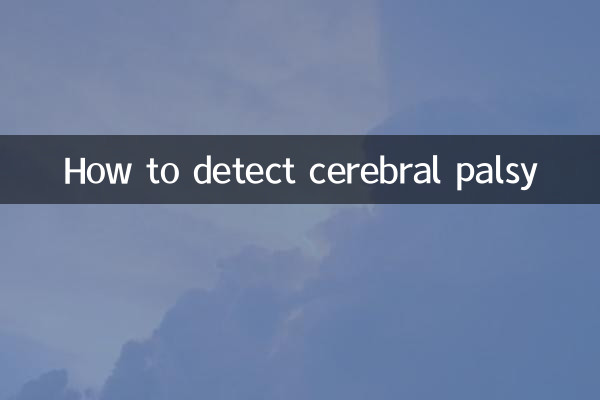How to detect cerebral palsy
Cerebral Palsy (CP) is a movement disorder caused by abnormal brain development or damage in fetus or infancy. Early diagnosis and intervention are crucial to improving children's quality of life. This article will introduce in detail the diagnostic methods, examination items and related data of cerebral palsy to help parents and medical staff better understand this disease.
1. Common diagnostic methods for cerebral palsy

The diagnosis of cerebral palsy usually requires a combination of clinical manifestations, imaging examinations, and laboratory tests. The following are common diagnostic steps:
| diagnostic methods | Specific content | meaning |
|---|---|---|
| clinical observation | Observe the children’s motor development, abnormal posture, changes in muscle tone, etc. | Preliminarily determine whether there is a movement disorder |
| Imaging examination | MRI, CT, ultrasound, etc. | Detect structural abnormalities or damage to the brain |
| Laboratory testing | Blood, genetic testing, etc. | Rule out other conditions that may cause similar symptoms |
| developmental assessment | GMFCS (Gross Motor Function Classification System) etc. | Assess the child’s motor function level |
2. Early screening indicators for cerebral palsy
Early screening is key to detecting cerebral palsy. Here are some common early screening indicators:
| age group | screening index | abnormal behavior |
|---|---|---|
| 0-6 months | Abnormal muscle tone and feeding difficulties | Muscles are too tight or too loose, causing weakness in sucking |
| 6-12 months | delayed motor development | Unable to roll over, sit up, or crawl |
| 1-2 years old | Difficulty walking and abnormal posture | Toe walking, scissor gait |
3. Imaging examination of cerebral palsy
Imaging examination is an important means of diagnosing cerebral palsy. The following are common examination methods and their characteristics:
| Check type | Applicable age | Detection content |
|---|---|---|
| cranial ultrasound | newborn | Detect cerebral hemorrhage, ventricular enlargement, etc. |
| MRI | Infants and above | Detailed display of brain structures and injuries |
| CT | emergency | Rapidly detect bleeding or structural abnormalities in the brain |
4. Differential diagnosis of cerebral palsy
Symptoms of cerebral palsy can be similar to other conditions, so a differential diagnosis is needed. Here are some diseases to rule out:
| Disease name | Differences from cerebral palsy |
|---|---|
| Inherited metabolic diseases | Often accompanied by metabolic abnormalities and progressive deterioration |
| spinal muscular atrophy | Mainly manifests as muscle weakness rather than dystonia |
| congenital hypothyroidism | Diagnosis can be confirmed with blood tests |
5. Intervention and treatment of cerebral palsy
After early diagnosis, timely intervention and treatment are crucial to improve children's function. The following are common interventions:
| intervention method | Specific content | Effect |
|---|---|---|
| physical therapy | Sports training, posture correction | Improve motor function and posture |
| occupational therapy | daily living skills training | Improve self-care ability |
| drug treatment | Relieve muscle tone and control epilepsy | Reduce symptoms and improve quality of life |
| surgical treatment | Correct deformities and relieve spasms | Improve severe movement disorders |
6. Summary
The diagnosis of cerebral palsy requires multidisciplinary collaboration, combining clinical manifestations, imaging examinations, and developmental assessments with multiple methods. Early screening and intervention are of great significance to improving the prognosis of children. If parents find that their children have abnormal motor development, they should seek medical attention promptly for early diagnosis and treatment.

check the details

check the details